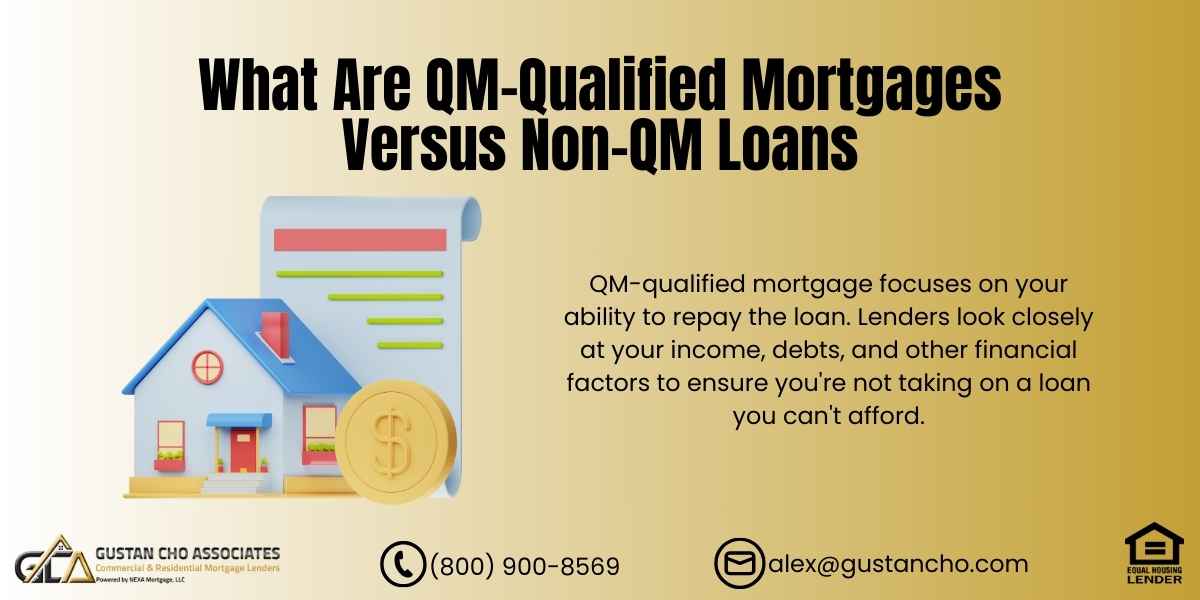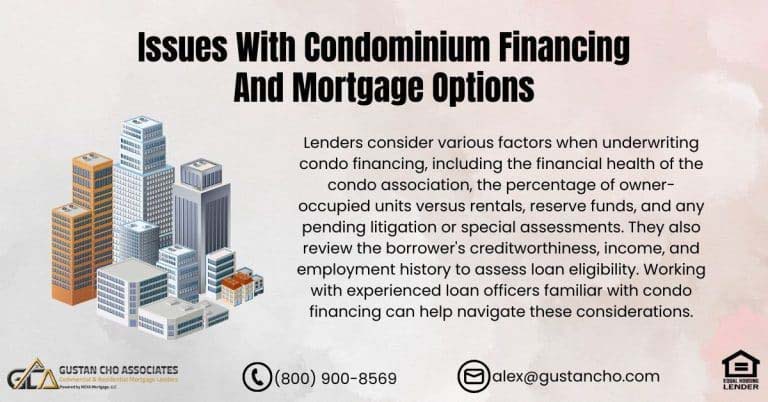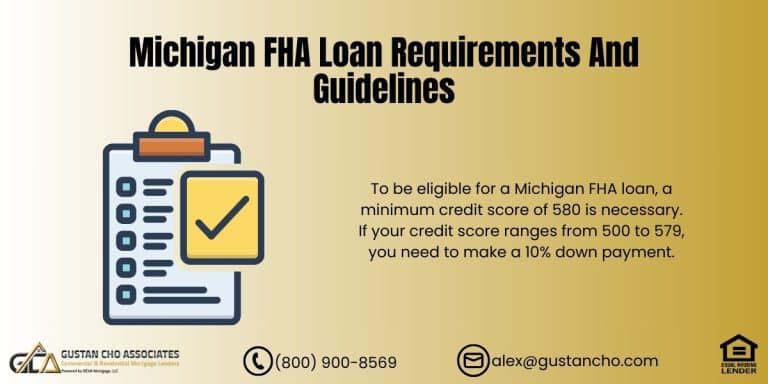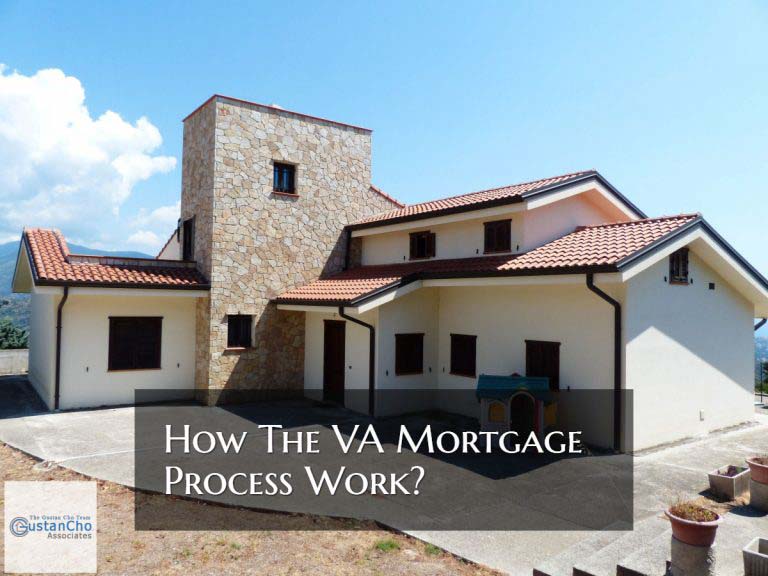Understanding QM-Qualified Mortgages: What Borrowers Need to Know in 2025
If you’re thinking about buying a home or refinancing, chances are you’ve heard about QM-qualified mortgages. But what exactly does it mean, and why does it matter to you as a borrower?
This blog will briefly summarize everything you need to know about QM-qualified mortgages. By the end, you’ll clearly understand whether a QM loan is right for you and how Gustan Cho Associates can help you get started.
What Are QM-Qualified Mortgages?
QM-qualified mortgages, or “Qualified Mortgages,” are home loans that meet specific rules designed to ensure borrowers can repay their loans. These rules were introduced on January 10, 2014, under the Dodd-Frank Act. The primary goal of QM-qualified mortgages is to protect both borrowers and lenders by preventing risky lending practices.
Simply put, a QM-qualified mortgage focuses on your ability to repay the loan. Lenders look closely at your income, debts, and other financial factors to ensure you’re not taking on a loan you can’t afford. It’s all about making lending safer and more sustainable.
Ready To Get A Qm-Qualified Mortgages
Apply Online And Get recommendations From Loan Experts
Why Are QM-Qualified Mortgages Important?
QM-qualified mortgages serve two main purposes:
- Protect Borrowers: QM-qualified mortgages are designed to help protect borrowers like you by closely examining your ability to repay the loan. This means they aim to ensure you don’t end up in a situation where you might face foreclosure or financial stress. By focusing on these factors, QM-qualified mortgages can help create a safer borrowing experience, making it easier to manage your payments without worrying about losing your home.
- Protect Lenders: QM-qualified mortgages are a type of loan that helps protect lenders from legal issues as long as they stick to the rules set out by the Qualified Mortgage guidelines. Lenders who play by these rules don’t have to worry as much about being sued. For borrowers, this can lead to more secure loan options and better protections overall when borrowing money.
At Gustan Cho Associates, we’re here to guide you through the QM loan process and ensure you understand how it works. Our goal is to make homeownership achievable and affordable for everyone.
Key Features of QM-Qualified Mortgages
To qualify as a QM-qualified mortgage, a loan must meet the following requirements:
1. Debt-to-Income Ratio (DTI)
Your monthly debt obligations, encompassing the new mortgage payment, generally shouldn’t surpass 43% of your gross income. However, don’t lose hope if your financial situation seems challenging, as exceptions exist.
For instance, if your loan receives approval via automated underwriting systems such as Fannie Mae’s DU (Desktop Underwriter) or Freddie Mac’s LP (Loan Prospector), you may still qualify even with a debt-to-income (DTI) ratio exceeding 50%. Remember, there’s always a pathway forward that could work in your favor!
2. No Risky Loan Features
QM loans cannot include risky features like:
- Interest-only payments
- Negative amortization (where your loan balance increases over time)
- Loan terms longer than 30 years
3. Limits on Fees
For most loans, loan points and fees cannot exceed 3% of the loan amount. Higher limits may apply for smaller loans, but this can still make low-dollar loans challenging.
4. Full Documentation
QM-qualified mortgages require full documentation of income, assets, and debts. This means no “stated income” or “no-doc” loans.
What Are Safe Harbor QM Loans?
A “Safe Harbor” QM loan offers lenders the highest level of legal protection. These loans meet all QM guidelines and demonstrate that the borrower’s repayment ability has been thoroughly verified. Safe Harbor loans are typically associated with lower risk and are easier for lenders to approve.
Many loans insured by organizations such as Fannie Mae, Freddie Mac, FHA, VA, or USDA can be considered Safe Harbor Qualified Mortgages. This means you can feel confident knowing that these loans meet specific regulatory standards, providing security in your financial decisions.
Updates to QM Guidelines in 2025
The mortgage industry has evolved significantly since QM-qualified mortgages were introduced. Here are the latest updates:
- Revised DTI Limits: While the 43% DTI cap remains a standard benchmark, automated underwriting systems allow more flexibility, especially for borrowers with strong credit profiles.
- Adjusted Loan Fee Thresholds: Loan points and fee thresholds are now adjusted annually for inflation, providing more clarity for smaller loan amounts.
- Inclusive Credit Scoring Models: New credit scoring models, such as FICO 10 and VantageScore 4.0, are being adopted, making it easier for borrowers with limited credit history to qualify.
At Gustan Cho Associates, we stay updated on these changes to provide the best options tailored to your unique financial situation.
QM-Qualified Mortgages vs. Non-QM Loans
So, how do QM-qualified mortgages compare to non-QM loans? Let’s take a closer look:
QM-Qualified Mortgages:
- Focus on the borrower’s ability to repay
- Offer lower interest rates
- Require full documentation
- Provide legal protections for lenders
Non-QM Loans:
- Designed for borrowers who don’t meet QM guidelines
- Include options like bank statement loans, asset-based loans, and interest-only loans
- Offer more flexibility in income verification
- Typically, they have higher interest rates
Non-QM loans are an excellent alternative for self-employed borrowers, real estate investors, or those with recent credit events like bankruptcy or foreclosure. Gustan Cho Associates specializes in QM and non-QM loans, ensuring you can access the right loan.
Who Benefits from QM-Qualified Mortgages?
QM-qualified mortgages are ideal for:
- First-time homebuyers with stable income and good credit
- Borrowers seeking competitive interest rates
- Homeowners looking to refinance with a traditional loan structure
If you’re unsure whether a QM loan is right for you, our experienced loan officers at Gustan Cho Associates can guide you through the decision-making process.
How to Qualify for a QM Loan
Qualifying for a QM loan involves these key steps:
- Check Your Credit Score: Many QM loans typically ask for a 620 minimum credit score or above. Remember, a higher score can significantly enhance your approval chances and secure more favorable rates. Keep striving for that goal!
- Calculate Your DTI: Make sure your monthly debts (including the mortgage) are within the acceptable range.
- Gather Documentation: Collect proof of your income, assets, and debts. This should include items like pay stubs, tax returns, and bank statements. By organizing these documents ahead of time, you set yourself up for a smoother process. Remember, having everything ready can significantly reduce stress.
- Work with a Trusted Lender: Working withElecting a trusted lender can truly transform your experience. At Gustan Cho Associates, we streamline the process, helping you access the best loan options available. Rest assured, we’re here to support you every step of the way!
Why Choose Gustan Cho Associates?
At Gustan Cho Associates, we specialize in helping borrowers navigate the complexities of QM-qualified mortgages and non-QM loans. Here’s what sets us apart:
- Expertise: Our knowledgeable team continuously monitors the newest mortgage guidelines and market trends. By staying informed, we ensure you receive the most accurate information and support as you navigate your financial options.
- Flexibility: We offer a variety of loan options so you can discover the one that meets your needs.
- Personalized Service: We genuinely invest effort into understanding your financial aspirations and supporting you throughout the journey.
Take the Next Step Today
Regardless of whether you are purchasing your first home, refinancing, or looking into non-QM options, Gustan Cho Associates is ready to support you. Contact us today at 800-900-8569 or alex@gustancho.com to connect with a dedicated loan officer who can guide you in turning your homeownership aspirations into reality. We are available 7 days a week, on weekends, and even on holidays.
Ready to get started? Apply Now and take the first step toward securing your QM-qualified mortgage today! Your journey to homeownership starts here!
Ready To Buy Your Dream Home By Qualify for QM Loan
Apply Online And Get recommendations From Loan Experts
Frequently Asked Questions About QM-Qualified Mortgages:
Q: What are QM-Qualified Mortgages?
A: QM-qualified mortgages are home loans that follow specific rules to make sure borrowers can repay them. They focus on your ability to pay back the loan by checking your income, debts, and financial stability.
Q: Why are QM-Qualified Mortgages Important?
A: They protect borrowers by ensuring loans are affordable and protect lenders from legal risks as long as they follow the rules. This makes lending safer for everyone.
Q: What is the Maximum Debt-to-Income (DTI) Ratio for QM-Qualified Mortgages?
A: Generally, your DTI should not exceed 43%. However, if other factors are strong, automated systems like Fannie Mae’s DU or Freddie Mac’s LP may allow higher DTIs, sometimes above 50%.
Q: Can I Qualify for a QM Loan if I am Self-Employed?
A: Absolutely, you can qualify for a QM loan as a self-employed individual! However, gathering comprehensive documentation, including your tax returns and bank statements, is essential to validate your income. Remember, QM loans require solid evidence of financial stability, so make sure you have everything organized to enhance your chances. You’ve got this!
Q: Are QM-Qualified Mortgages Available for First-Time Homebuyers?
A: Absolutely! QM loans are great for first-time buyers with stable incomes and good credit. They offer competitive rates and help make homeownership more accessible.
Q: How do QM Loans Differ from Non-QM Loans?
A: QM loans adhere to stringent regulations, providing borrowers with lower interest rates, and require comprehensive documentation. In contrast, non-QM loans present greater flexibility, making them suitable for individuals who may not meet conventional criteria. However, it’s important to note that these loans may have higher interest rates. This flexibility can open up opportunities for borrowers who face unique financial situations.
Q: Do QM-Qualified Mortgages have Prepayment Penalties?
A: The good news is that most QM loans are designed without prepayment penalties. This means you can pay off your loan early without worrying about additional fees, giving you more flexibility in your financial journey.
Q: What Kind of Documentation do I Need for a QM Loan?
A: You’ll need proof of income, assets, and debts, such as pay stubs, tax returns, and bank statements. Full documentation is required to qualify.
Q: Are There Exceptions to the 3% Loan Fee Cap for QM Loans?
A: Yes, higher fee limits may apply for smaller loan amounts. However, smaller loans can still be challenging due to the cost of compliance.
Q: Why Should I Work with Gustan Cho Associates for a QM Loan?
A: Gustan Cho Associates offers expertise, flexible loan options, and personalized service. We’re dedicated to guiding you through the process and finding the best mortgage for your needs.
This blog about “What Are QM-Qualified Mortgages Versus Non-QM Loans” was updated on January 14th, 2025.










